Waterfall
How the Source of a Waterfall Begins: A Complete Guide for Nature Lovers

Key Takeaways
- Waterfalls are powered by natural water sources such as rivers, rainfall, springs, and glaciers.
- Geological features and environmental conditions shape the origin of waterfalls.
- Human activities and climate changes affect waterfall ecosystems.
Have you ever stood before a waterfall, captivated by its beauty, and wondered where all that water comes from? Waterfalls are among nature’s most stunning features, but their origins remain a mystery to many. Understanding how the source of a waterfall begins isn’t just fascinating—it also helps us appreciate the intricate balance of nature that sustains these wonders.
Let’s dive into the journey of water, from its origins to becoming a cascading waterfall.
What Is the Source of a Waterfall?
A waterfall’s source is simply the origin of the water that flows over its edge. Think of it as the starting point of a waterfall’s story. This water can come from many natural sources, like rain, rivers, melting glaciers, or underground springs.
No matter the source, one thing stays consistent: gravity. Waterfalls form when water flows over a steep drop or cliff, often shaped by the land’s geological features.
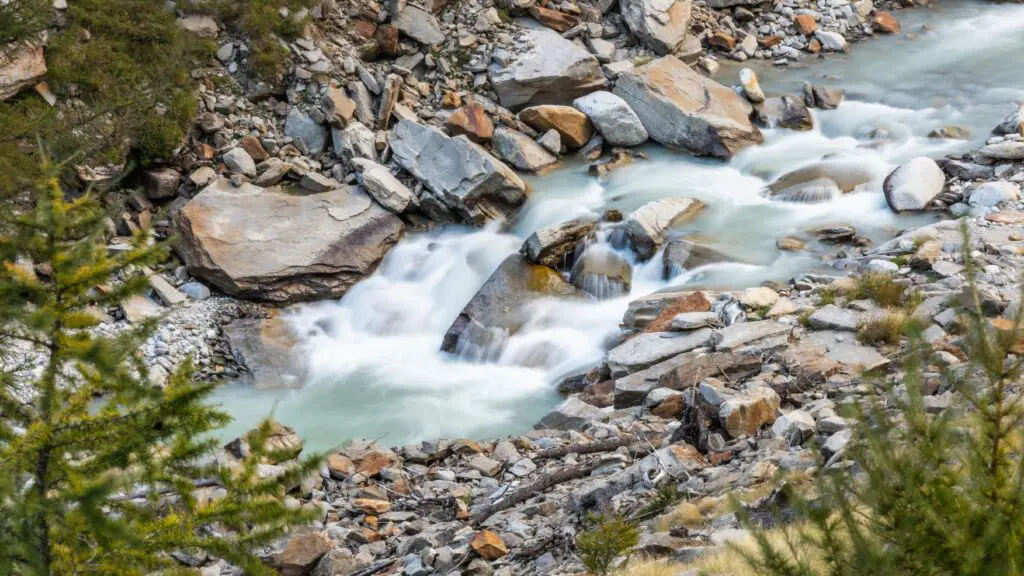
Natural Sources That Feed Waterfalls
Rainfall and Surface Runoff
Rain is one of the most common contributors to waterfalls. When rainwater collects on the surface, it can flow downhill, forming streams or rivers. In regions with heavy rainfall, these streams grow larger and can create powerful waterfalls. For example, seasonal waterfalls in tropical areas heavily rely on rainfall.

Rivers and Lakes
Many famous waterfalls are powered by large rivers or lakes. Rivers like the Zambezi fuel iconic waterfalls such as Victoria Falls. Similarly, lakes can overflow and form waterfalls when their water spills over rocky edges.
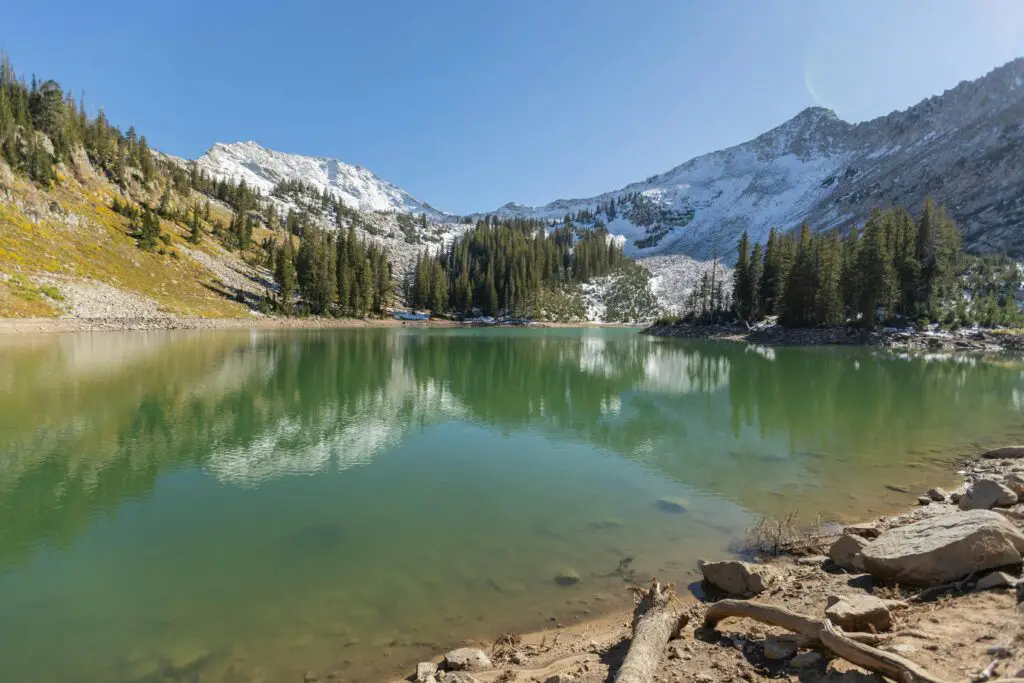
Melting Snow and Glaciers
In colder climates or mountainous regions, melting snow and glaciers are significant water sources. For instance, Angel Falls in Venezuela starts with streams from the Auyán-tepui mountain. This kind of water source is particularly important in high-altitude areas.

Underground Springs
Sometimes, water seeps through the ground and emerges as natural springs. These springs can feed smaller streams, which eventually lead to waterfalls. This type of source is common in limestone-rich regions.

How Terrain and Geology Shape Waterfalls
Waterfalls owe much of their beauty to the land they flow over. A steep cliff, hard rock layers, and soft sediments all play a role in their formation. Over time, erosion caused by flowing water can carve paths, creating dramatic drops. Here’s how:
- Hard Rock Layers
Harder rocks resist erosion, forming the cliff or edge of the waterfall. Softer rock beneath it erodes faster, creating the plunge.
- Fault Lines
Movements in the Earth’s crust, like tectonic activity, can create cracks or drops in the terrain, giving birth to waterfalls.
- River Erosion
Rivers erode the land over thousands of years, forming valleys, gorges, and steep drops where waterfalls emerge.
The Role of Climate in Waterfall Sources
The climate has a huge impact on waterfalls. In regions with wet and dry seasons, waterfalls may flow strongly in the rainy season but shrink—or even disappear—in dry months. On the other hand, glaciers and snowmelt waterfalls depend on colder climates to sustain their water supply.
Climate change poses a significant threat. Rising temperatures can reduce glacier sizes, cutting off the source for many iconic waterfalls.
Human Impact on Waterfall Sources
Humans, for better or worse, have a massive influence on natural water sources. Deforestation, dam construction, and overuse of water resources can disrupt the flow that feeds waterfalls. For example:
- Dams on rivers can reduce water flow, leading to smaller or even disappearing waterfalls.
- Urbanization alters natural runoff patterns, impacting smaller waterfalls fed by rainfall.
Preserving these sources is crucial not just for their beauty but also for the ecosystems they support.
Famous Waterfalls and Their Sources
- Niagara Falls: Powered by water from the Great Lakes.
- Victoria Falls: Fed by the Zambezi River.
- Angel Falls: Originates from mountaintop streams in Venezuela.
- Iguazu Falls: Formed by the Iguazu River between Argentina and Brazil.
These waterfalls show how diverse their sources can be.
FAQs About Waterfall Sources
What causes waterfalls to form?
Waterfalls form when water flows over a steep drop or cliff, often shaped by erosion, tectonic activity, or varying rock types.
Are all waterfalls seasonal?
No, not all waterfalls are seasonal. Some, like Niagara Falls, have a constant water supply, while others depend on seasonal rain or snowmelt.
Can human activities affect waterfalls?
Yes, human activities like damming rivers, deforestation, and urban development can significantly impact waterfall ecosystems.
Conclusion
Waterfalls are a testament to the power and beauty of nature. Their sources, whether rivers, rainfall, glaciers, or springs, connect the land and water in a delicate balance. By understanding their origins, we can better appreciate—and protect—these incredible natural wonders. Next time you visit a waterfall, take a moment to think about the journey the water has taken to get there.
Ready to learn more about the magic of waterfalls? Explore guides on their formation and history to deepen your appreciation of these natural treasures!
Waterfall
Benefits of Waterfalls to a Country: A Deep Dive into Their Economic, Environmental, and Cultural Impact

Key Takeaways
- Waterfalls boost a country’s economy through tourism and job creation.
- They play a key role in maintaining biodiversity and supporting ecosystems.
- Many waterfalls hold cultural, spiritual, and historical significance.
- Waterfalls offer opportunities for clean energy generation through hydroelectric power.
- Preserving waterfalls is essential to combat environmental threats like pollution and deforestation.
Introduction
Waterfalls aren’t just mesmerizing natural wonders; they’re powerful assets for any country. From driving tourism and economic growth to protecting the environment and fostering cultural connections, waterfalls have a lot to offer. Whether it’s the thunderous roar of Niagara Falls or the serene beauty of smaller local cascades, these natural marvels can transform landscapes and communities alike.
But have you ever wondered why they matter so much beyond their scenic beauty? Let’s explore the profound benefits waterfalls bring to a country, from economic development to environmental preservation and cultural enrichment.

How Do Waterfalls Benefit a Country?
Waterfalls aren’t just pretty to look at—they serve as economic engines, environmental protectors, and cultural treasures. Let’s take a closer look at how they help.
Economic Benefits of Waterfalls
1. Attracting Tourists
Waterfalls are major tourist attractions. Their beauty draws millions of visitors each year, boosting local tourism industries. Think about globally famous sites like Niagara Falls or Iguazu Falls. These places generate billions in revenue for surrounding businesses like hotels, restaurants, souvenir shops, and tour operators.
For smaller countries, even local waterfalls can be game-changers. By attracting travelers, they can create vibrant economies and encourage regional development.
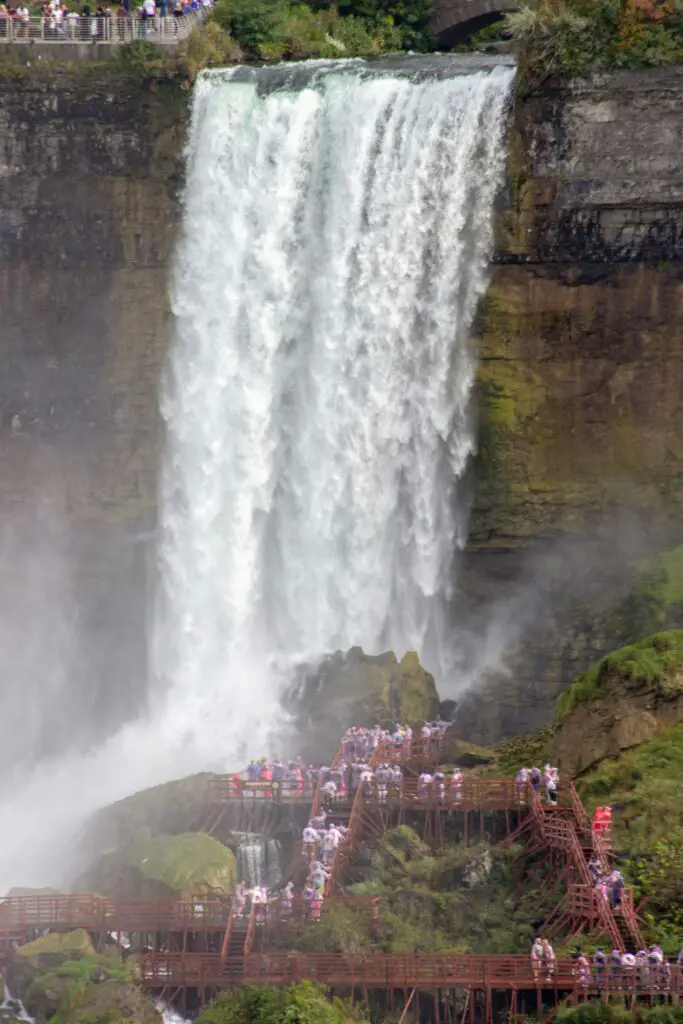
2. Creating Jobs
Tourism around waterfalls leads to the creation of jobs. People work as tour guides, conservation officers, and service staff in nearby hotels and restaurants. Additionally, construction projects to improve infrastructure—like roads and viewing platforms—create temporary and permanent employment opportunities.

3. Supporting Local Businesses
Tourists often buy local goods, from handmade crafts to regional foods. This directly supports small businesses and encourages economic growth. By promoting eco-friendly tourism around waterfalls, countries can make this economic cycle more sustainable.

Environmental Benefits of Waterfalls
1. Protecting Biodiversity
Waterfalls are hotspots for biodiversity. They create unique habitats for plants, animals, and microorganisms that can’t thrive elsewhere. For instance, many rare species rely on the cool, misty microclimates created by waterfalls.
When countries protect waterfalls, they help preserve these fragile ecosystems and contribute to global efforts to conserve biodiversity.
2. Natural Water Filtration
Waterfalls contribute to the natural filtration of water. As water flows over rocks, it gets aerated, improving its quality. These processes support nearby aquatic ecosystems and ensure cleaner rivers downstream.
3. Regulating Climate
The spray and mist from waterfalls contribute to local humidity levels, which in turn regulate the surrounding climate. Forests and vegetation near waterfalls also absorb carbon dioxide, helping combat climate change.

Cultural and Social Importance of Waterfalls
1. Spiritual and Historical Value
Many waterfalls are sacred sites. Indigenous communities often regard them as spiritual places, with stories and rituals passed down through generations. For example, in Hawaii, waterfalls are seen as sacred gifts from the gods.
2. Recreation and Community Bonding
Waterfalls are perfect spots for recreation, from hiking to picnicking. They offer a chance to connect with nature and strengthen bonds with family and friends. For photographers and artists, waterfalls inspire creativity and provide stunning backdrops.

Renewable Energy Opportunities
1. Hydroelectric Power Generation
Waterfalls are natural sources of kinetic energy. Countries use them to generate hydroelectric power, which is clean and renewable. For example, hydroelectric plants in Iceland use waterfalls to produce sustainable electricity.
2. Promoting Sustainable Development
By tapping into waterfall-generated energy, countries can reduce their reliance on fossil fuels. However, it’s important to balance energy projects with environmental protection to avoid harming ecosystems.

Challenges and Preservation Efforts
1. Environmental Threats
Pollution, deforestation, and over-tourism can harm waterfalls. When forests are cut down or rivers are polluted, the ecosystems around waterfalls suffer.
2. Conservation Strategies
Governments and communities can adopt conservation policies, like restricting access to vulnerable sites or investing in eco-friendly infrastructure. Local education programs can also teach visitors and residents the importance of protecting waterfalls.
FAQs
What are the economic benefits of waterfalls?
Waterfalls boost tourism, create jobs, and support local businesses by attracting visitors and encouraging spending in surrounding areas.
How do waterfalls help the environment?
They support biodiversity, act as natural water filters, and help regulate local climates.
Can waterfalls produce energy?
Yes! Waterfalls are often used to generate hydroelectric power, providing a clean and renewable energy source.
Why are waterfalls culturally significant?
Many communities see waterfalls as sacred or historical landmarks, and they serve as venues for recreation, storytelling, and inspiration.
Conclusion
Waterfalls are more than just beautiful sights—they’re vital assets that enrich countries economically, environmentally, and culturally. By preserving these wonders, countries can ensure long-term benefits for their people, ecosystems, and industries. Whether they’re powering communities with clean energy, inspiring spiritual connections, or supporting rare wildlife, waterfalls truly make a country richer in every sense.
So next time you visit a waterfall, take a moment to appreciate its impact—not just on the scenery, but on the world around it.
Waterfall
What Are the Things to Follow When Climb Down a Waterfall?

Key Takeaways:
- Always check and prepare your gear before starting.
- Learn the proper climbing techniques for safety.
- Take it slow, steady, and stay aware of your surroundings.
- Never skip safety assessments like checking weather and water flow.
- Communication and teamwork are essential.
Climbing down a waterfall is an exciting yet challenging adventure. If you’re a thrill-seeker who loves nature, the sound of water rushing around you and the beauty of a waterfall make this experience unforgettable. But wait—it’s not as easy as it looks! Descending a waterfall can quickly turn dangerous if you’re not careful.
Whether you’re trying this for the first time or looking to sharpen your skills, you must follow specific steps to stay safe and enjoy the experience. In this guide, we’ll break down everything you need to know to climb down a waterfall safely and confidently.
Understanding the Challenges of Climbing Down a Waterfall
Before you strap on your harness and ropes, you need to understand that climbing down waterfalls (also called canyoning or rappelling) comes with unique challenges.
- Slippery Rocks: Water constantly flowing over rocks makes them slippery and unstable. You can easily lose your balance.
- Strong Water Currents: Even small waterfalls can push you off your footing with their force. Larger ones are even more dangerous.
- Hidden Obstacles: Sharp rocks, loose stones, or debris beneath the water can cause injuries if you’re not cautious.
- Weather Risks: Rain can change the water flow quickly, making a manageable waterfall turn into a powerful surge.
Being aware of these challenges helps you prepare for what lies ahead.
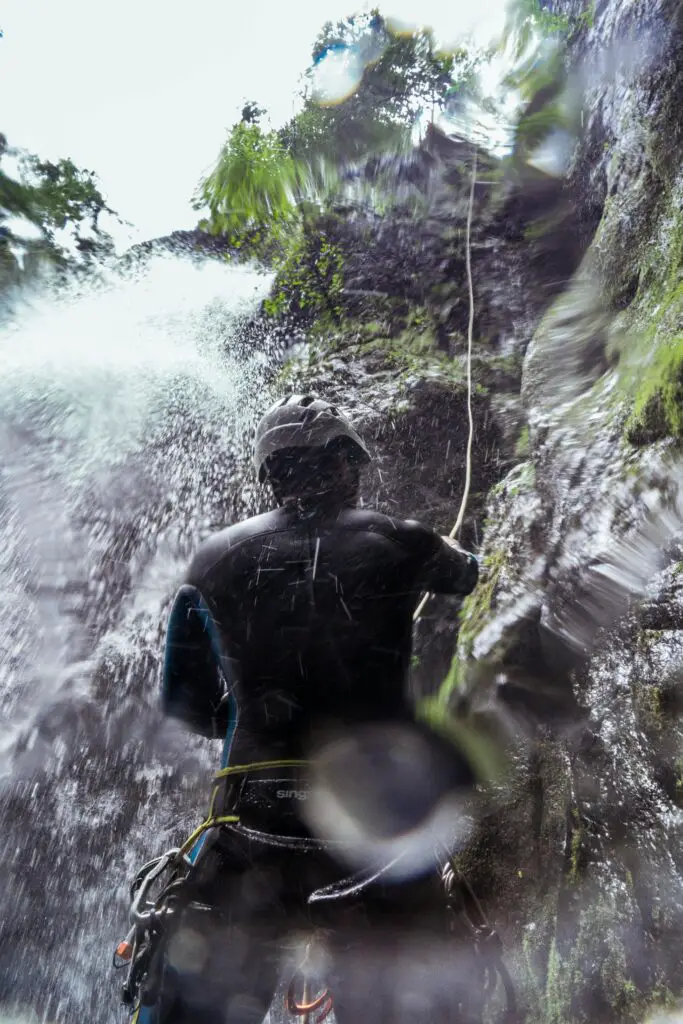
Essential Things to Follow Before Descending a Waterfall
1. Check Your Gear and Equipment
Safety begins with your gear. Without the right tools, climbing down a waterfall becomes dangerous. Here’s what you need:
- Helmet: Protects your head from falling debris or accidents.
- Harness and Ropes: A strong, well-maintained harness and ropes are your lifelines. Double-check for damage.
- Shoes: Wear sturdy, waterproof shoes with excellent grip. Normal sneakers or sandals won’t work.
- Carabiners and Belay Devices: These tools help secure you to the ropes and manage your descent.
- Dry Bags: Keep your phone, first aid kit, and essentials dry in waterproof bags.
Always inspect your gear before you start. If anything looks worn out, replace it or borrow good-quality equipment.

2. Conduct a Safety Assessment
Before you take the first step, spend time evaluating the waterfall and its surroundings.
- Check Water Flow: Is the water flowing calmly or aggressively? Avoid waterfalls with heavy surges.
- Spot Hidden Hazards: Look for sharp rocks, loose stones, or areas where water pressure increases suddenly.
- Assess Weather Conditions: Rain upstream can lead to flash floods. Even a light drizzle can make the rocks more slippery.
When in doubt, it’s better to wait or find another waterfall than to take unnecessary risks.
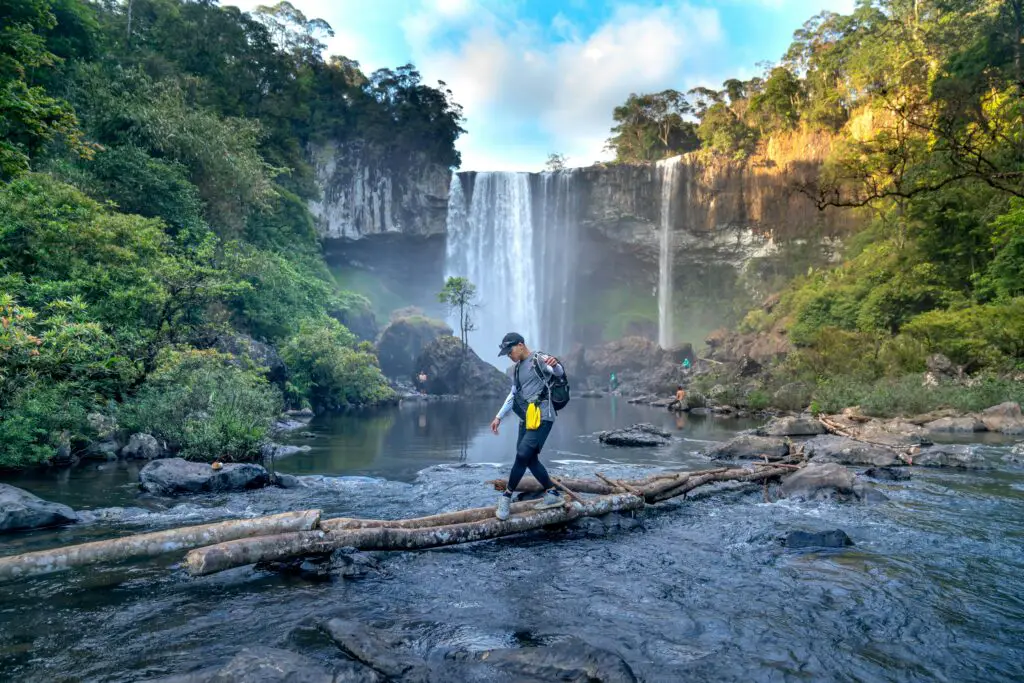
3. Prepare Yourself Physically and Mentally
Descending waterfalls requires both physical strength and mental focus.
- Build Your Strength: You’ll need strong arms, legs, and core muscles to manage ropes and maintain balance. Practice climbing exercises beforehand.
- Stay Calm: If things get difficult, don’t panic. Take deep breaths, steady yourself, and focus on what’s next.
Even experienced climbers remind themselves to stay alert, confident, and calm throughout the process.

4. Learn Proper Techniques from Professionals
If this is your first time, don’t attempt it alone. Learn the correct techniques under the supervision of trained professionals or guides.
- Body Positioning: Lean back at a 45-degree angle with your feet planted firmly on the rocks.
- Rope Management: Keep your descent slow and controlled. Never let the rope slip through your hands too fast.
- Foot Placement: Move one foot at a time. Find secure footholds before shifting your weight.
Taking lessons will not only help you feel safer but will also build the skills needed for more complex climbs.

Safety Guidelines While Climbing Down a Waterfall
1. Use the Correct Descending Technique
Keep your body relaxed but steady as you move. Lean back slightly and face forward so you can see where you’re going. Always trust your rope and equipment.
2. Take It Slow and Steady
Never rush when climbing down a waterfall. Quick movements can make you slip or lose balance. Take small, careful steps and use your hands to guide yourself on slippery surfaces.
3. Communicate with Your Team
If you’re descending with a group, stay in constant communication. Let others know when it’s safe to follow or when you spot a hazard. Working together ensures everyone stays safe.
4. Be Aware of Your Surroundings
Keep an eye out for falling rocks, sudden water changes, or unexpected obstacles. Stay focused on the waterfall and its behavior as you descend.


What to Avoid When Climbing Down a Waterfall
- Skipping Safety Checks: Never start without inspecting your gear or the waterfall.
- Climbing Alone: Always climb with experienced friends or guides.
- Overestimating Your Skills: Know your limits. Don’t attempt high or fast waterfalls without proper training.
- Ignoring the Weather: Bad weather can create dangerous water flows in minutes.
Benefits of Following Safety Measures
By following these safety tips and steps, you can:
- Enjoy the adventure without risking injuries.
- Gain confidence in your waterfall rappelling skills.
- Focus on the fun and beauty of the experience instead of worrying about safety.

Conclusion
Climbing down a waterfall is an incredible adventure, but it comes with real risks. To stay safe, prepare thoroughly, use proper gear, learn the techniques, and always climb with caution. Follow the steps outlined in this guide, and you’ll be ready for a thrilling yet secure waterfall adventure. Remember, safety is the key to enjoying the climb!
FAQs
1. What gear do I need to climb down a waterfall?
You’ll need a helmet, harness, ropes, waterproof shoes, and carabiners.
2. Is climbing down a waterfall dangerous?
It can be if you’re unprepared. With proper gear, training, and caution, it’s a safe and enjoyable activity.
3. Can beginners climb down waterfalls?
Yes, but it’s essential to learn from professionals and start with small, manageable waterfalls.
4. How do I check if a waterfall is safe to climb?
Assess water flow, weather conditions, and look for hidden hazards like sharp rocks or unstable surfaces.
5. Should I attempt waterfall climbing alone?
No, always climb with a group or a professional guide to ensure safety.
By following this guide step by step, even beginners can climb down waterfalls safely. Enjoy the thrill and stay safe!
Waterfall
What is the Highest Waterfall in the World in Venezuela?

Key Takeaways:
- Angel Falls, located in Venezuela, is the highest waterfall in the world, standing at 979 meters (3,212 feet).
- It has a continuous drop of 807 meters (2,648 feet) from the top of Auyán-Tepui.
- Angel Falls is part of Canaima National Park, a UNESCO World Heritage Site.
- The falls were named after Jimmy Angel, an aviator who brought worldwide attention to it in 1933.
- Known locally as Kerepakupai Merú, it holds immense cultural and natural significance.
The World’s Tallest Waterfall: Angel Falls in Venezuela
Imagine standing at the foot of a massive cliff, surrounded by lush rainforests and hearing the roar of water cascading down from a height so great that some of it evaporates into mist before it even reaches the ground. That’s Angel Falls in Venezuela for you—the highest waterfall on Earth!
But what makes Angel Falls so special? Why does it leave travelers from all over the globe in awe? Let’s dive into everything you need to know about this natural wonder, from its jaw-dropping height to its fascinating history and how you can visit it.

What Is Angel Falls?
Angel Falls, or Salto Ángel in Spanish, is an awe-inspiring waterfall located in the heart of Venezuela. It drops a staggering 979 meters (3,212 feet) from the top of Auyán-Tepui, a massive flat-topped mountain in Canaima National Park. Its uninterrupted drop of 807 meters (2,648 feet) makes it the tallest single-drop waterfall in the world.
The water originates from tropical rainfall on the Auyán-Tepui plateau, flowing over the edge to create this mesmerizing cascade. This sheer height is why it’s not only a bucket-list destination for nature lovers but also a source of national pride for Venezuela.

The History Behind Angel Falls
Angel Falls wasn’t “discovered” by the modern world until the early 20th century, but indigenous Pemon people had known about it for centuries, calling it Kerepakupai Merú, which means “waterfall of the deepest place.
In 1933, Jimmy Angel, an American aviator searching for gold, flew over the falls and was struck by its beauty. He later attempted to land his plane on the top of Auyán-Tepui, but his plane got stuck, and he and his crew had to hike down. His adventure popularized the falls, which were later named after him.
Where Is Angel Falls Located?
Angel Falls is tucked away in Canaima National Park in southeastern Venezuela, near the border with Brazil and Guyana. This national park is a UNESCO World Heritage Site, known for its otherworldly landscapes, unique tepuis (tabletop mountains), and rich biodiversity.
Auyán-Tepui, the mountain from which Angel Falls drops, is one of the largest tepuis in the park, covering 700 square kilometers (270 square miles). Its steep cliffs and dramatic drop make it one of the most photographed spots in South America.

Visiting Angel Falls: A Once-in-a-Lifetime Adventure
How to Get There
Visiting Angel Falls isn’t as simple as driving up to it—it’s a true adventure. The falls are located in a remote jungle, so you’ll need to get there either by:
- Plane: Most visitors fly from Caracas or Ciudad Bolívar to Canaima, the nearest town.
- Boat and Hike: From Canaima, you’ll take a boat along the Carrao and Churún rivers, followed by a hike through the rainforest to reach the base of the falls.
Best Time to Visit
The best time to visit is during the rainy season, from May to November, when the waterfall is at its fullest. In the dry season, water flow decreases significantly, and parts of the cascade may even dry up.
What Makes Angel Falls Unique?
- Height and Mist: Its immense height means the water disperses into a fine mist before reaching the ground. This creates a surreal, dream-like atmosphere.
- Tepuis: Auyán-Tepui is part of the ancient Guiana Shield, one of the oldest geological formations on Earth. The tepuis are home to unique plants and animals found nowhere else.
- Cultural Significance: For the Pemon people, Angel Falls is not just a natural wonder; it’s a sacred site deeply rooted in their traditions.
Fun Facts About Angel Falls
- Angel Falls is nearly 16 times taller than Niagara Falls!
- Its water flow varies depending on the season, but it’s always breathtaking.
- It was featured in the Disney-Pixar movie Up, inspiring the fictional “Paradise Falls.”
- Jimmy Angel’s airplane, El Río Caroní, is now displayed at the airport in Ciudad Bolívar.
FAQs About Angel Falls
1. How Was Angel Falls Formed?
Angel Falls was formed by erosion over millions of years. Rainfall on the Auyán-Tepui carved out the cliffs, creating the perfect conditions for this towering waterfall.
2. Why Is It Called Angel Falls?
The name comes from Jimmy Angel, the American pilot who made the world aware of the falls in 1933.
3. Can You Swim at Angel Falls?
Yes, you can swim in the natural pool at the base of the falls, but be prepared for cold water!
4. Is Angel Falls Accessible Year-Round?
Not entirely. During the dry season (December to April), river levels may drop, making boat access difficult.
Conclusion
Angel Falls is more than just the highest waterfall in the world—it’s a testament to the beauty and wonder of nature. Its breathtaking height, rich history, and remote location make it a must-see for adventurers and nature lovers alike. Whether you’re gazing at its misty cascade or trekking through the surrounding rainforest, visiting Angel Falls is an unforgettable experience.
For anyone planning a trip, be sure to respect the environment and the local communities that call this region home. Let’s help preserve this natural wonder for generations to come!
-

 Animals12 months ago
Animals12 months agoTypes of Ants Living in the World and Information
-

 Forests12 months ago
Forests12 months agoThe 10 Best Forests to Visit in the World
-

 Ocean1 year ago
Ocean1 year agoOceans in the World and Their Information & Locations
-

 Forests4 years ago
Forests4 years agoWhat Is The Biggest Rainforest In The World?
-

 Animals4 years ago
Animals4 years agoMost Popular Wild Animals in The World
-

 Animals4 years ago
Animals4 years ago(10) Insects Are Animals in the world?
-

 Forests12 months ago
Forests12 months agoThe Main Factors That Contribute to Forest Destruction
-

 Nature10 months ago
Nature10 months agoThe 10 Largest Farms in the World




